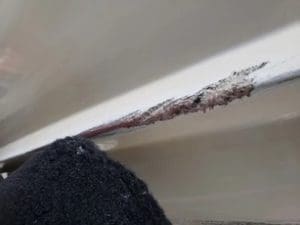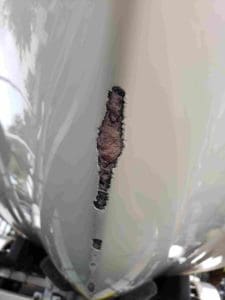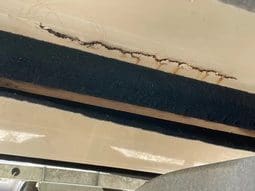
As a fiberglass boat repair professional in the Charleston SC area, I come across many boats where some are in need of immediate repairs and others are not such a priority but how does the average boater know the difference? This will hopefully give you some idea of where you stand as you assess your boat this spring for the upcoming summer.
If you are a seasonal or regular boater, then chances are at some point that your boat is going to come into contact with something other than just the water. It could be a dock, another boat, an anchor, a trailer bunk, or something that is bound to leave a mark. The majority of fiberglass boats in the southeast are gelcoat painted and this can include skiffs, flats boats, bay boats, open center console boats, offshore boats, pleasure cruise boats, sailboats, and yachts. Gelcoat is applied at a greater thickness than regular painted vessels which does give some added protection but it is still susceptible to damage, but how much damage should concern you? Hopefully, this information can help you assess any damage to your boat and determine how much of a priority it is to get it repaired.

Typically, gelcoat repairs in Charleston consist of chips or gouges where the boat has made contact with another object. It’s easy to perform an assessment of your boat, simply get out and do a thorough walkthrough of your boat being sure to check underneath of your boat from the bow to the stern and along the strakes underneath on both sides of the trailer bunks that are famous for hiding damaged areas. To begin, if you see a damaged area on your boat and you can see the fiberglass underneath of your gelcoat then you should call and schedule a repair. The fiberglass will typically look green, yellow or red based on the manufacturer’s resin that was used in the building process. Conversely, if you have a few chips or gouges and you can still see the original color of your gelcoat underneath, then there is no immediate need to get it repaired and it can wait until the off-season. Bear in mind that gelcoat is porous and over time the water can get beneath the gelcoat and cause further damage such as blisters. More importantly, if you have exposed fiberglass that is continually getting submerged in the water can penetrate the integrity of the resin and fiberglass creating much more serious structural concerns such as delamination where the water begins to separate the layers of fiberglass.
Probably the most prominent boat repair done in South Carolina to Florida is damage to the keel along with the bow from running on sandbars, oysters and/or improper trailering. Generally, the damage is cosmetic and the repair is nothing more than applying a few layers of gelcoat. In some cases, the keel needs to be built back up to its original shape with fiberglass. In either case, you do not want a soft keel bouncing around in the harbor or offshore so it is best to get it checked out by a Charleston boat repair shop.
Another common gelcoat repair is spider cracks which are typically found along the deck of the boat either in corners or along the gunnels. This is typically where too much gelcoat was applied and the torquing or flexing of the fiberglass hull of a boat albeit in the water or on a trailer causes the thicker gelcoat to create small hairline cracks at the flex points. This repair is not a priority in a structural integrity sense. However, these hairline cracks can extend over time from a 2-inch crack to a 2-foot crack in a matter of months which will greatly increase the cost of your repair. It is not uncommon to see spider cracks on brand new boats as they were rushed through the finishing process. A common fix by the DIY crowd or lazy boat repair shops is to fill spider cracks with either gel or compound and apply a new gelcoat overtop. While this may look like a fix on the surface at first glance, but the crack remains and will reappear in a matter of days or weeks. There is a proper way to fixing spider cracks that takes a more labor-intensive approach but is guaranteed to prevent them from reappearing.
Lastly, are the fiberglass repairs to restore structural integrity to the boat. It should go without saying but nonetheless if you’re boat has a hole, puncture, crack, etc. where your boat is taking on water even in the slightest, it should be taken out of the water and fixed immediately before returning to the water. A small crack in a transom can leave you drifting in your lifejacket within minutes. Boating in Charleston can be a blast but preventable accidents can be avoided with a thorough walk-through of your boat every so often.

If you are in need of gelcoat or fiberglass boat repair in the Charleston SC area, then do not hesitate to give us a call at Total Boat Repair (843) 940-1008. We make it a priority to provide outstanding results for our customers as we are a fully mobile boat repair company serving the greater Charleston area.
